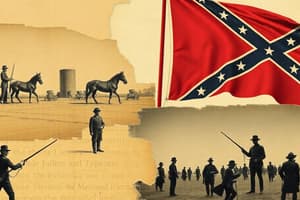Podcast
Questions and Answers
How did the invention of the cotton gin contribute to the rise of sectionalism in the United States?
How did the invention of the cotton gin contribute to the rise of sectionalism in the United States?
- It encouraged Southern farmers to diversify their crops, reducing their reliance on Northern industries.
- It increased the profitability of cotton production, strengthening the South's dependence on enslaved labor and differentiating its economy from the North. (correct)
- It facilitated the growth of textile mills in the North, leading to increased economic cooperation between the regions.
- It led to a decrease in the demand for slave labor in the South, angering Northern abolitionists.
Which of the following best describes the primary goal of Henry Clay's American System?
Which of the following best describes the primary goal of Henry Clay's American System?
- To establish free trade agreements with European nations and promote international commerce.
- To promote westward expansion by acquiring new territories from foreign powers.
- To limit the power of the federal government and increase states' rights.
- To foster economic independence and unity within the United States through protective tariffs, a national bank, and internal improvements. (correct)
How did the concept of Manifest Destiny influence westward expansion in the United States during the 19th century?
How did the concept of Manifest Destiny influence westward expansion in the United States during the 19th century?
- It encouraged peaceful negotiations with Native American tribes for land acquisition.
- It promoted the conservation of natural resources and the establishment of national parks in newly acquired territories.
- It supported the idea of halting expansion at the Mississippi River to avoid conflicts over slavery.
- It provided a moral justification for territorial expansion, leading Americans to believe they were destined to spread their culture and institutions across the continent. (correct)
What was the significance of the Missouri Compromise of 1820 in the context of rising sectionalism?
What was the significance of the Missouri Compromise of 1820 in the context of rising sectionalism?
Which event is most directly associated with the forced relocation of Native American tribes from their ancestral lands in the southeastern United States?
Which event is most directly associated with the forced relocation of Native American tribes from their ancestral lands in the southeastern United States?
How did the Monroe Doctrine shape the United States' foreign policy in the early 19th century?
How did the Monroe Doctrine shape the United States' foreign policy in the early 19th century?
What was a significant consequence of the War of 1812 that contributed to the Era of Good Feelings?
What was a significant consequence of the War of 1812 that contributed to the Era of Good Feelings?
How did westward expansion impact the relationship between the United States government and Native American tribes?
How did westward expansion impact the relationship between the United States government and Native American tribes?
Which treaty established the border between the United States and Spanish territories, ultimately leading to the U.S. acquisition of Florida?
Which treaty established the border between the United States and Spanish territories, ultimately leading to the U.S. acquisition of Florida?
What role did canals play in the economic changes taking place in the U.S. during the early 19th century?
What role did canals play in the economic changes taking place in the U.S. during the early 19th century?
How did protective tariffs contribute to rising sectionalism in the United States?
How did protective tariffs contribute to rising sectionalism in the United States?
What was the primary purpose of the Lewis and Clark expedition?
What was the primary purpose of the Lewis and Clark expedition?
How did the expansion of suffrage (voting rights) during the early 19th century affect American politics?
How did the expansion of suffrage (voting rights) during the early 19th century affect American politics?
Which of the following describes the 'spoils system' as practiced during the Jacksonian era?
Which of the following describes the 'spoils system' as practiced during the Jacksonian era?
What was the significance of the Convention of 1818?
What was the significance of the Convention of 1818?
Flashcards
Free Enterprise
Free Enterprise
An economic system with limited government interference.
Sectionalism
Sectionalism
Loyalty to a particular region's interests, rather than to the country as a whole.
Nationalism
Nationalism
Strong loyalty and devotion to one's nation.
Manifest Destiny
Manifest Destiny
Signup and view all the flashcards
Monroe Doctrine (1823)
Monroe Doctrine (1823)
Signup and view all the flashcards
Eli Whitney
Eli Whitney
Signup and view all the flashcards
Missouri Compromise (1820)
Missouri Compromise (1820)
Signup and view all the flashcards
Trail of Tears
Trail of Tears
Signup and view all the flashcards
Era of Good Feelings
Era of Good Feelings
Signup and view all the flashcards
The American System
The American System
Signup and view all the flashcards
Cotton Gin
Cotton Gin
Signup and view all the flashcards
Adams-Onis Treaty (1818)
Adams-Onis Treaty (1818)
Signup and view all the flashcards
Study Notes
- The early 19th century was a pivotal period in U.S. history, shaped by sectionalism, nationalism, and westward expansion.
Key Vocabulary
- Free Enterprise: An economic system with limited government interference.
- Census: An official count of a population.
- Canal: An artificial waterway for transportation.
- Capitalism: An economic system based on private ownership and free markets.
- Spoils System: The practice of giving government jobs to political supporters.
- Cotton Gin: A machine that quickly separates cotton fibers from their seeds.
- Plurality: The largest number in a group, but not a majority.
- Majority: More than half of a total.
- Depression: A severe economic downturn.
- Tariff: A tax on imports or exports.
- Sectionalism: Loyalty to a particular region's interests.
- Manifest Destiny: The belief that the U.S. was destined to expand across North America.
- Nationalism: Strong loyalty and devotion to one's nation.
- Annex: To add territory to a country.
- Bureaucracy: A system of government with many departments.
- Nomination Conventions: Meetings where political parties choose their candidates.
Important Figures and Events
- Monroe Doctrine (1823): U.S. opposed European colonization in the Americas.
- Eli Whitney: Invented the cotton gin.
- Adams-Onis Treaty (1818): Established the border between the U.S. and Spanish territories.
- Convention of 1818: Set the 49th parallel as the U.S.-British North American border.
- Rush-Bagot Treaty (1817): Limited naval forces on the Great Lakes.
- Missouri Compromise (1820): Maintained the balance of free and slave states.
- Trail of Tears: Forced relocation of Native American tribes.
The Era of Good Feelings
- It was a period of strong nationalism after the War of 1812.
- James Monroe was president from 1817-1825.
- A one-party political system temporarily emerged.
- There was economic growth and westward expansion.
- Sectional tensions were building beneath the surface.
Rising Sectionalism
- Growing differences developed between the North, South, and West.
- Economic interests: industry vs. agriculture.
- Slavery became a divisive issue.
- There were debates over tariffs and internal improvements.
- Regional identities were strengthening.
Nationalism and "The American System"
- Henry Clay's plan aimed at strengthening the nation.
- Protective tariffs were meant to support American industry.
- A national bank was intended to stabilize currency.
- Internal improvements (roads, canals) were built to connect the country.
- It was designed to unite different regions economically.
Westward Expansion
- It was driven by population growth and the desire for new opportunities.
- It was fueled by the Manifest Destiny ideology.
- The Louisiana Purchase (1803) doubled the size of the U.S.
- The Lewis and Clark expedition took place from 1804-1806.
- There were conflicts with Native American tribes.
- New states were added to the Union.
The Cotton Gin and Southern Economy
- Eli Whitney invented the cotton gin in 1793.
- Cotton production dramatically increased.
- The plantation system and slavery were strengthened in the South.
- Cotton became America's leading export.
- Economic differences between the North and South widened.
The Trail of Tears
- The forced relocation of Native American tribes occurred in the 1830s.
- It was a result of the Indian Removal Act of 1830.
- The Cherokee, Muscogee, Seminole, Chickasaw, and Choctaw nations were primarily affected.
- Thousands died during the journey.
- More land was opened up for white settlers.
The Missouri Compromise
- It was an 1820 agreement to maintain balance between free and slave states.
- Missouri was admitted as a slave state.
- Maine was admitted as a free state.
- Slavery was prohibited north of the 36°30' parallel in the Louisiana Territory.
- Sectional tensions were temporarily eased.
Legacy and Impact
- It was a period of significant growth and change for the United States.
- Foundations were laid for future conflicts (e.g., Civil War).
- American political and economic systems were shaped.
- There were lasting effects on Native American populations.
- America's role on the world stage was influenced.
Studying That Suits You
Use AI to generate personalized quizzes and flashcards to suit your learning preferences.




